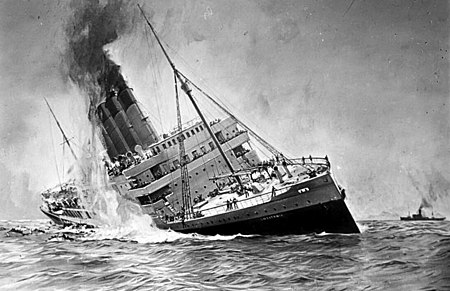Real life war strategies are very interesting to me, compared to randos sharing top 10 tips and tricks on LinkedIn. This is a story of a prescient book, how a major warning was ignored and almost turned the tide of World War One. In 1914, right before the war, Arthur Conan Doyle, he of Sherlock Holmes fame, was so worried about the Germans’ submarine superiority that he wrote a freaking novel about it.

Rendering of the real life sinking of RMS Lisutania by a U-boat in 1915
In Doyle’s short story Danger!, Norland a tiny country in the North Sea, gets into a war against Great Britain. The story is about how the tiny nation brings the mighty British empire to its knees with 8 submarines (U-boats)!!! The strategy was simple – the isle of Great Britain was a net importer of food and other vital supplies since the island nation could not sustain enough agriculture and other activities to support its entire population and wartime efforts.
In Danger!, Norland U-boat armada Captain John Sirius (in hindsight) correctly guesses that if you starved the British isles by cutting off the shipping lanes which imported food and other essential supplies, they would have no option but to surrender. In the story, Capt Sirius essentially skips all open confrontation with the might British navy and their destroyers (hilariously named Dreadnoughts) and wages guerilla warfare at sea by concentrating on hapless merchant and supply ships with 8 U-boats only. What made this tactic unique was that marine warfare norms at that point in history (both in real life and in the book) frowned upon attacking civilian and merchant ships.
The aftermath of this successful strategy is described as follows in the book:
> In the great towns starving crowds clamoured for bread before the municipal offices, and public officials everywhere were attacked and often murdered by frantic mobs, composed largely of desperate women who had seen their infants perish before their eyes. In the country, roots, bark, and weeds of every sort were used as food. In London the private mansions of Ministers were guarded by strong pickets of soldiers, while a battalion of Guards was camped permanently round the Houses of Parliament. The lives of the Prime Minister and of the Foreign Secretary were continually threatened and occasionally attempted. Yet the Government had entered upon the war with the full assent of every party in the State.
Doyle’s warning was largely ignored by the British admiralty because they believed that no nation would violate the current rules of war. Sure enough, a few months after the land war in Europe, now known as World War 1 broke out, Germany went on the offensive with their U-boats and soon pivoted to include non-military ships. The British navy had no real answer to these attacks until much later in the war and at certain points risked a plight similar to the one in the book.
The other prescient aspect of Doyle’s fiction was the repeated mention of a channel tunnel which would’ve established a land based route between mainland Europe and the isle to have a contingency plan. The Channel Tunnel would not open for another 80 years in real life.
Some real life lessons to learn from Danger! and Norland’s strategy, when going against a superior opponent:
- When forced to go against an insurmountable force, avoid direct attacks – Capt Sirius avoided any direct confrontations especially against destroyers and other war ships.
- Avoid playing by the rules and conventions largely laid out by the enemy – It was accepted convention that civilian and merchant vessels were to be left alone. Capt Sirius knew his tiny nation stood no chance if he played by convention and directly went against it.
- Go for the choke points and focus on destroying them swiftly – Recognizing that the imported food supply was Great Britain’s weak point, Capt Sirius wages all-out war focused against the supply lines only.
- Expend only the bare minimum of resources – Capt Sirius leaves the rest of the conventional navy at home, and uses 8 swift moving and strategically placed U-boats to maximum effect.
Conversely, if you’re the larger force:
- Learn to recognize your weaknesses and threats to them, however remote those threats may seem
- Work on contingency plans
Some interesting reads: